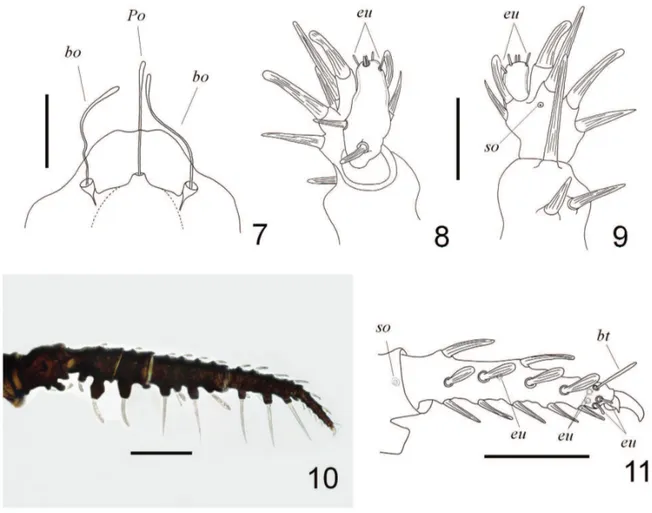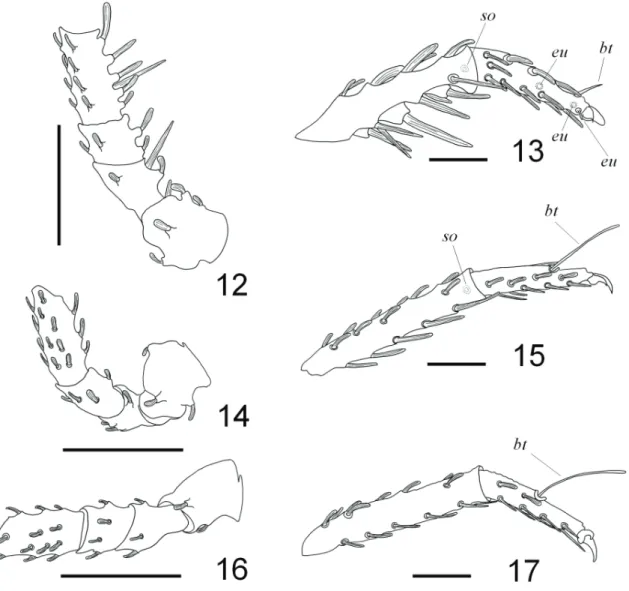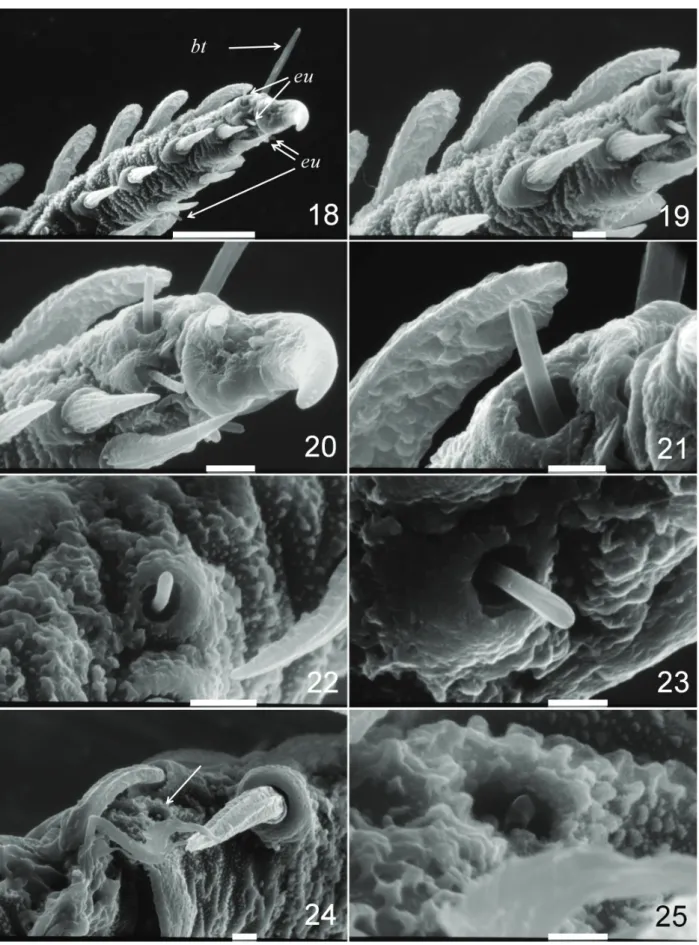A new species of
Andocaeculus
(Acari, Caeculidae) from the Pampa biome,
southern Brazil
Ana Paula Ott1 &Ricardo Ott2
1. Departamento de Fitossanidade, Faculdade de Agronomia, Universidade Federal do Rio Grande do Sul. Av. Bento Gonçalves, 7712, 91540-000, Porto Alegre, RS, Brazil. (ana.ott@ufrgs.br) 2. Museu de Ciências Naturais, Fundação Zoobotânica do Rio Grande do Sul. Rua Dr. Salvador França, 1427, 90690-000, Porto Alegre, RS, Brazil. (rott@fzb.rs.gov.br)
ABSTRACT. A new caeculid species Andocaeculus caioi sp. nov. is described from Pampa biome in south Brazil. The species of this family are usually large and strong sclerotized mites with robust and spinulose legs I and II. Until now records of species for South America were known only from Chile and Argentina.
KEYWORDS. Mite, Neotropical, South America, taxonomy.
RESUMO. Uma nova espécie de Andocaeculus (Acari, Caeculidae) do bioma Pampa, sul do Brasil. Uma nova espécie de caeculídeo, Andocaeculus
caioi sp. nov., é descrita para o bioma Pampa no sul do Brasil. As espécies desta família apresentam o corpo bastante esclerotizado e as pernas I e II com espinhos robustos. Até o momento, registros de espécies desta família na América do Sul eram conhecidos apenas para o Chile e Argentina.
PALAVRAS-CHAVE. Ácaro, neotropical, América do Sul, taxonomia.
The Pampa biome is an extensive natural grasslands region located between northeastern Argentina, Uruguay and south of Brazil (Suertegaray& Silva, 2009). This region includes some very fragile environments and is of common sense that the presence of grasslands and the hindering of forest expansion over the area are nowadays
greatly influenced by the human activities. In the other hand this activities has great negative influence on the
conservation of the natural areas and the biodiversity of the region (roeSch et al., 2009). The region focused in this paper (Área de Proteção Ambiental - APA - do Ibirapuitã; approximate coordinates 29°57’22” - 30°51’55”S, 55°21’02” -55°55’13”W) is a federal protection area which includes private owned land around the almost whole extension of the Ibirapuitã River (icMBio, 2014).
Caeculidae are usually large and strong sclerotized mites which prey on Collembola (otto, 1993). The family is usually linked with arid habitats around the world (taylor et al., 2013). The Caeculidae includes nowadays 97 extant species distributed in seven genera (taylor et al.,
2013). At least five species are known from South America:
Andocaeculus brundini (Franz, 1962), Neocaeculus bruchi (Berlese, 1916) and Microcaeculus weyrauchi Franz, 1964 from Argentina; M. castrii Franz, 1964 and M. nudus Franz, 1964 from Chile.
The family was first revised by Franz (1952) and later by coineau (1974) which included an extensive analysis of morphological and also ecological aspects of some species. The last author proposes also the genus Andocaeculus to include “all South American species described by Franz”: “Ce genre est destine à recevoir lês espèces que H. Franz a fait connaitre d’Amérique du
Sud” (coineau, 1974:279). Based on this comment we
suspect that all species described by Franz(1962, 1964)
should be transferred to Andocaeculus. However, this seems to be not accepted once Andocaeculus remains as a monotypic genus including until now only the designed genus type species A. brundini (see tayloret al., 2013:448; checklist of Caeculidae provided by Yves Coineau). The three remaining Microcaeculus species described by Franz (1964) for South America were apparently not examined by coineau (1974) and therefore never formally revised or transferred to Andocaeculus.
All species of the three Caeculidae genera with South American distribution (Andocaeculus Coineau, 1974; Microcaeculus Franz, 1952 and Neocaeculus Coineau, 1967) can be recognized by the tarsal claws of different size on leg I. Andocaeculus, differently from the remaining two genera, can be recognized by the presence of one bothridium on the dorsal side of tarsi I and II as in Caeculus Doufour, 1832 (see coineau 1974:279). Neocaeculus and Microcaeculus should be recognized by differences in the aspidosomal sclerite length, not dorsally overhanging the
gnathosoma in the first and overhanging in the second
(coineau, 1967; coineau & ennS, 1969; taylor et al., 2013). Regarding biogeographic distribution it’s worth to mention that types species and most species of the genera Microcaeculus and Neocaeculus do not have Neotropical distribution being mostly and respectively from Paleartic and Australian regions.
In this paper we describe a new species of
Andocaeculus from South America, the first caeculid
registered to Brazil.
MATERIAL AND METHODS
Descriptions follows mainly taylor et al. (2013),
modified for the description of legs spines position and
Spines location and counts were accomplished using
compound and stereomicroscope for confirmation. Incident
light images were taken through a stereomicroscope with attached camera and processed with Helicon Focus 5.3 multi-range program (KozuB et al., 2012). Transmitted light images of cleared female were taken with a compound microscope using a digital camera and also processed with Helicon Focus. Drawings were made using printed images as models and compound microscope and stereomicroscope
as three-dimensional shape confirmation tools. Electron scanning microscope (SEM) images were taken using a
Jeol-JSM-5200 with attached SLR digital camera. All
measurements in text are in millimeters; SEM scale bars
are in micrometers.
Examined material is deposited at acarological
collection of Museu de Ciências Naturais da Fundação Zoobotânica do Rio Grande do Sul (MCN, curator R. Ott).
Etymology. The noun in apposition is a patronym in
honour to Mr. Caio Silveira owner of the Fazenda Rincão dos Moraes and full supporter of the research activities on
the Federal Environment Protection Area of the Ibirapuitã
River (“APA do Ibirapuitã”).
Diagnosis. Andocaeculus caioi sp. nov. can be recognized by the tarsal bothridia on the legs I and II. The species differs from A. brundini by the absence of aspidosomal setae Pp and dorsal setae a1 and b1; can be also recognized by the paired setae b2 and c2 and by two setae at anterior face of trochanter II.
Description. Female (MCN ACA 1891, paratype). Idiossoma length 1.594; width 1.079.
Dorsum: orange brown tegument with dark brown to blackish sclerites (in ethanol; Fig. 1). Aspidosomal sclerite blackish, 0.451 long, 0.386 wide; setae Pa on anterior third of sclerite at the high of the anterior largest sclerite portion, setae Pm and Pp absent (Figs 3, 5). Two
Figs 7-11. Andocaeculus caioi sp. nov., paratype ♀: 7, anterior portion of aspidosoma, dorsal view. Palp: 8, ventral view; 9, dorsal view. 10, Leg I,
prolateral view; 11, distal metatarsus and tarsus I, prolateral view (Po, naso setae; bo, bothridium; bt, tarsal botridium; so, solenidion; eu, eupathidium). Scale bars: 7, 0.1 mm; 8, 9, 0.05 mm; 10, 0.25 mm; 11, 0.1 mm.
between b2 and c2, close to the border of the sclerite (Figs 3, 5). Medial sclerites dark brown with blackish ridges, close to reniform shape, apart from each other around its half width, 0.113 long, 0.274 wide; setae d1, d2 present, ds absent. Posterior sclerites rounded with a mesal somewhat narrowed tip, close together, dark brown with blackish ridges, 0.174 long, 0.258 wide; setae e1, e2 present, es absent; three additional setae present on postero-lateral position of each sclerite (Fig. 5). Pseudoanal sclerite less sclerotized, orange brown, only seta hs present.
Venter: orange brown tegument suffused with brown
setae. Genital valves with six pairs of small and thin needle-like setae, genital opening 0.209 long; aggenital sclerite inconspicuous. Anal valve with two pairs of small clavate setae; pseudoanal sclerites with three setae; 0.225 long (Figs 4, 6). Remaining ventral agenital seta distribution as in Figs 4, 6.
Chelicera with one dorso-distal needle-like seta; movable
finger terminal, fixed finger regressed and tooth like. Palp
(Figs 8, 9) four segmented, with fused femur-genu bearing three dorsal robust needle-like setae, distal one longer as proximal ones; tibia with six robust setae, three dorsal ones and one anterior, all about same length, two smaller retrolateral ones, one dorsal solenidion (Fig. 9); tarsus with
two ventral setae, both prolaterally directed, five eupathidia:
four distal ones being the two median very close together,
the fifth one slightly in retrolateral position (Figs 8, 9).
Legs: blackish with white to light yellowish setae. Leg setae clavate or needle-like shaped, arranged mainly
in five rows, ventral rows bearing mostly needle-like seta;
all clavate setae mostly on anterior, dorsal or posterior rows. Legs I and II bearing very long needle-like setae (mainly on anterior and ventral sides of femur, genu and tibia) originating on large tubercles (Figs 10, 12, 13). Leg
I with five eupathidia, all restricted to tarsus, being four
distal ones at base of claws (two on each side) and one at
middle length in retrolateral position (Figs 11, 18-21); one distal solenidion on retrolateral side of tibia (Figs 11, 24, 25), one dorsal short bothridium distally on tarsus (Figs 11, 18); clavate setae distribution: tr, a1-1, d0-1; bf, a1-0-0, d0-0-1, p0-1-0, vp1-1-0; fe, a1-0, d0-1, p1-0, vp1-0; ge, a1-1-0-1, d1-1-1-1, 1-1; ti, a1-1-1-1, d1-1-1-0, p1-1-1-1; ta, a1-1-1-1, p1-1-0-0; needle-like setae distribution: bf, va1; fe, va1; ge, va1-1-0, v1-0-0, vp1-1-0; ti, va1-1-1, vp1-1-1; ta, va1-1-1-1-1, vp1-1-1-1-1. Leg II with three eupathidia, all restricted to tarsus, being two distal ones (the prolateral one at base of claws and the retrolateral one somewhat appart from claws, Figs 13, 26, 27) and one at middle length in retrolateral position (Figs 13, 29); one distal solenidion on tibia in retrolateral position (Fig. 13); one dorsal short bothridium on distal position of tarsus (Figs 13, 26-28); clavate setae distribution: tr, a1-1, d0-1, p0-1; bf, a1-0, d0-1, p1-0; fe, a1-1, d0-1, p1-0; ge, a1-1-0-1, d1-1-1-1, p1-1-1-1; ti, a1-1-1-1, d1-1-1-0, p1-1-1-1; ta, a1-1-1-1, p1-1-0-0; needle-like setae distribution: bf,
Figs 12-17 Andocaeculus caioi sp. nov., paratype ♀: 12, 14, 16, trochanter, basifemur, femur and genu, dorso-prolateral view; 13, 15, 17, metatarsus
Figs 18-25. Andocaeculus caioi sp. nov., paratype ♀, scanning electron microscope images, Leg I: 18, tarsus, ventro-prolateral view; 19, same,
detail; 20, tarsal claws, same view; 21, distal eupathidium, same view; 22, tarsal medial eupathidium, ventral view; 23, same, dorsal view; 24, distal metatarsus, ventral-retrolateral view (arrow: solenidion); 25, Same, solenidion detail (bt, tarsal bothridium; eu, eupathidium). Scale bars: 18, 50
Figs 26-31. Andocaeculus caioi sp. nov., paratype ♀, scanning electron microscope images, Leg II: 26, tarsus, retrolateral view; 27, same,
dorso-prolateral view; 28, tarsal bothridium, basal detail, same view; 29, tarsal medial eupathidium, dorso-retrolateral view; 30, metatarsal ventral spines, retrolatertal view; 31, metatarsal clavate spine, retrolateral view (bt, tarsal bothridium; eu, eupathidium). Scale bars: 26, 27, 29-31, 10 μm; 28, 5 μm.
vp1-1; ge, va0-1-1, vp1-0-0; ti, va1-1-1, v1-0-1; vp1-1-1; ta, va1-1-1-1-1, vp1-1-1-1-1. Leg III with one distal solenidion on tibia in retrolateral position (Figs 15, 33, 34); one dorsal long bothridium at three quarters of the length of tarsus (Fig. 15); clavate setae distribution: tr, a1-0, d0-1, p0-1; bf, d0-1, p0-1, va0-1, vp1-1; fe, a1, d1, p1, va1, vp1; ge, a1-1-1-1, d1-1-1-0, p1-1-1-1, va1-1-1-0, vp1-0-0-1; ti, a1-1-1-0-1, d0-0-0-1-va1-1-1-0, p1-1-1-1-1; ta, a1-1-1-1, p1-1-1-0; needle-like setae distribution: ti, va1-1-1-1-1, vp1-1-1-1-1; ta, va1-va1-1-1-1-1, vp1-1-1-1-1. Leg
IV with one dorsal long bothridium at middle length of tarsus (Figs 17, 36, 37); clavate setae distribution: tr, d1, p1; bf, d0-1, p0-1, va0-1, vp1-1; fe, a1, d1, p1, va1, vp1; ge, a1-1-0-1, d1-1-1-0, p1-1-0-1, va1-0-1-1, vp1-0-1-0; ti, a1-1-0-0-1, d0-0-0-1-0, p1-1-1-0-1; ta, a1-1-1, p1-1-0; needle-like setae distribution: ti, va1-1-1-1-1, vp1-1-1-1-1; ta, va1-1-1-1-1, vp1-1-1-1-1.
Male. Unknown
Other examined material. 7♀ (MCN ACA
1892-1898) all 31.I.2014, R. Ott, M. Pairet & G. O. Silva leg; all same location as type material.
Distribution. Known only for the type locality. Behaviour. Similar as reported by coineau (1974: pl. 3, 17) it was observed on live specimens that mites can present thanatosis behaviour in different positions (spread legs, withdrawn legs or irregular legs position) for many minutes, not moving even if pushed around (Figs 38-40).
Natural History. Specimens were collected under exfoliating basalt stones near a small creek (Fig. 41). Further examined material was collected in many other sites in the same area but not necessary close to water
bodies (Figs 42). As also noted by otto (1993) we suspect that the species is a specialized Collembola predator as
many Entomobryidae were observed under the same rocks
where the mites were found; unfortunately we were not able to catch any of them.
Acknowledgements. To RS Biodiversidade Project for financial support. To Antonio D. Brescovit (Instituto Butantan) for providing copies of the extensive Yves Coineau 1974 thesis. To ICMBio crew at
Apa do Ibirapuitã, Eridiane Lopes da Silva and Raul Cândido da Trindade Paixão Coelho for help and support. For the Silveira family (Fazenda Rincão dos Moraes) for all the kind reception and logistic support. For Mariano Cordeiro Pairet Jr. and Guilherme Oyarzabal da Silva for the
invaluable help on field.
Figs 32-37. Andocaeculus caioi sp. nov., paratype ♀, scanning electron microscope images, 32-34, leg III and 35-37, leg IV: 32, tarsal claws, dorsal
view; 33, distal metatarsus, retrolateral view (arrow: solenidion); 34, same, solenidion detail; 35, tarsal claws, dorsal retrolateral view; 36, bothridium,
Figs 38-42. 38-40, Andocaeculus caioi sp. nov., tanathosis positions images: 38, 39, dorsal view; 40, ventral view. 41,42, Tipical A. caioi sp. nov. habitat in exfoliating basalt outcrops (arrows), Pampa Biome, Área de Proteção Ambiental do Rio Ibirapuitã, Sant’Ana do Livramento, Brazil.
REFERENCES
coineau, Y. 1967. Contribuition à létude des Caeculidae, Troisième série.
Développment postlarvaire de Neocaeculus luxtoni n. gen., n. sp. Acarologia 9(1):55-75.
_____. 1974. Éléments pour une monographie morphologique, écologique et biologique des Caeculidae (Acariens). Mémoires du Museum National d’Histoire Naturelle, Série A, Zoologie 81:1-299.
coineau, y. & ennS, W. R. 1969. Contribuition a l’étude des Caeculidae. 8e série. Deux nouvelles espèces d’Australie: Neocaeculus knoepffleri n. sp.; N. bornemisszai n. sp. Acarologia 11(4):207-221.
Franz, h. 1952. Revision der Caeculidae Berlese 1883. Bonner Zoologische Beriträge 3:91-124.
_____. 1962. Ein neuer Microcaeculus aus Südamerika (Acari:
Trombidiformes). Verhandlungen der zoologisch-botanischen Gesellschaft in Wien 101-102:98-100.
_____. 1964. Neue Caeculiden aus Afrika und Südamerika. Verhandlungen der zoologisch-botanischen Gesellschaft in Wien 103-104:82-93.
icMBio, 2014. Apa de Ibirapuitã. Avaliable at: <http://www.icmbio.gov. br/portal/biodiversidade/unidades-de-conservacao/biomas-brasileiros/ pampa/unidades-de-conservacao-pampa/2233-apa-de-ibirapuita. html>. Accessed on: 20 April 2014.
Köppen, W. 1948. Climatologia. Cidade do México, Fondo de Cultura. p. 152-192.
KozuB, D.; KhMeliK, K.; Shapoval, J.; chentSov, v.; litovSchenKo, B. & StariKh, v. 2012. Helicon Focus 5.3. Helicon Focus Ltda.
Available at: <http://cybercom.net/~dcoffin/dcraw/>. Accessed on:
23 May 2013.
otto, J. c. 1993. A new species of Microcaeculus from Australia (Acarina:
Caeculidae), with notes on its biology and behaviour. International Journal of Acarology 19(1):3-13.
roeSch, l. F. W.; vieira, F. c. B.; pereira, v. a.; SchüneMann, a. l.;
teixeira, i. F.; Senna, a. J. t. & SteFenon, v. M. 2009. The Brazilian Pampa: A Fragile Biome. Diversity 1:182-189.
Suertegaray, D. M. a. & Silva, l. a. p. 2009. Tchê Pampa: histórias da natureza gaúcha. In: pillar, v. p.; Müller, S. c.; caStilhoS, z. M. S. & JacqueS, a. v. a. eds. Campos Sulinos: conservação e
uso sustentável da biodiversidade. Brasília, Ministério do Meio Ambiente. p. 42-62.
taylor, c. K.; gunaWarDene, n. r. & Kinnear, a. 2013. A new species of Neocaeculus (Acari: Prostigmata: Caeculidae) from Barrow Island, Western Australia, with a checklist of world Caeculidae. Acarologia 53(4):439-452.






